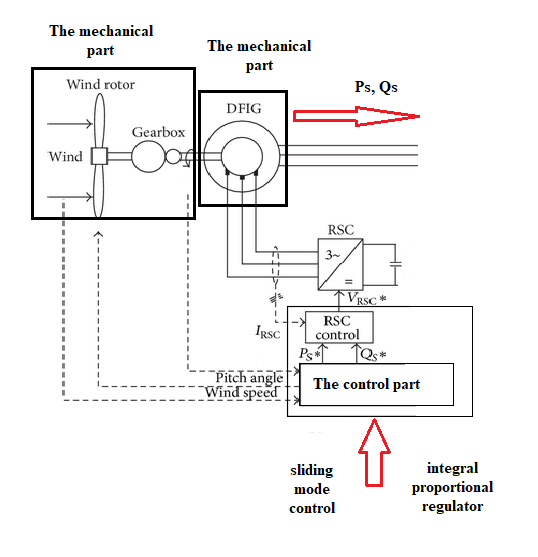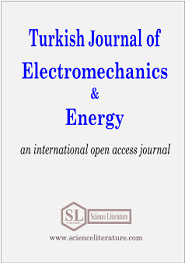
Control of a wind power system based on a doubly fed induction generator with a sliding mode controller
Abstract
Wind energy is a type of renewable energy when wind turbines convert the wind into mechanical or electrical energy. This energy is used to generate the energy needed in many different areas, such as industry and agriculture. Wind power is one of the most important energy sources for scientific researchers because of its importance. The main factor of this energy is the wind, a natural phenomenon that occurs in the world without human interference. This work presents the description and modelling of the wind power system based on the dual-feed generator. The technique of maximum power point tracking with speed control has been used to achieve the objective of good operation with improved effective utilization of the wind turbine. Two different methods are applied for speed control. A classical proportional-integral controller and an advanced sliding mode controller are considered by speed control and reactive and active power control. At the end of the modelling and simulation of the whole in the MATLAB/Simulink environment, the analysis of the results shows good performances.
Full Text:
PDFReferences
D. Song, et al., “Maximum power extraction for wind turbines through a novel yaw control solution using predicted wind directions,” Energy Convers. Manag, vol. 157, pp. 587–599, February 2018.
M. E. Şahin, H. İ. Okumuş, “Comparison of different controllers and stability analysis for photovoltaic powered buck-boost DC-DC converter,” Electric Power Components and Systems, 46(2), pp. 149-161, 2018.
J. M. Adánez, B. M. Al-Hadithi, A. Jiménez, “Wind turbine
multivariable optimal control based on incremental state model,”
Asian J. Control, vol. 20, pp. 1–13, December 2018.
S. Jie, A. Qian, “ Research on several key technical problems
in realization of smart grid. Power Syst,” Prot. Control, 37(19), pp. 1-4, 2009.
A. Z. Mohamed, M. N. Eskander, F. A . Ghali, “Fuzzy logic
control based maximum power tracking of a wind energy system,” Renew. Energy, vol. 23, pp. 235–245, 2001.
S. H. Lee, Y.J. Joo, J. Back, J.H. Seo, “ Sliding mode controller
for torque and pitch control of wind power system based on PMSG,” In: International Conference on Control, Automation and Systems, ICCAS, pp. 1079–1084, December 2010.
G. Balta, Ç. Hi̇sar, N. Altin, “Artificial intelligence based switching frequency regulation with fast terminal sliding mode control for DC–DC step-down converters,” Expert Systems with Applications, vol. 228, pp. 12033, October 2023.
M. Martinez-Lopez, J. Moreno-Valenzuela, W. He, “A robust nonlinear PI-type controller for the DC–DC buck–boost power converter,” Isa transactions, vol. 129, pp.687-700, October 2022.
M.E. Şahın, H.I Okumuş, H. Kahvecı, “Sliding mode control of PV powered DC/DC Buck-Boost converter with digital signal processor”. In: 17th European Conference on Power Electronics and Applications, EPE'15 ECCE Europe, pp.1-8, September 2015.
H. Afghoul, F. Krim, D. Chikouche, A. Beddar, “Design and
real-time implementation of a fuzzy-switched controller for single
phase active power filter,” ISA Trans, vol. 58, pp. 614–621, 2015.
Y. Daili, J. P. Gaubert, L. Rahmani, A. Harrag, “Quantitativ
feedback theory design of robust MPPT controller for small wind energy conversion systems: Design, analysis, and experimental study,” Sustainable Energy Technologies and Assessments, vol. 35, pp 308-320, October 2019.
G. Balta, N. Altin, and A. Nasiri, “Interval type-2 fuzzy-logic-based constant switching frequency control of a sliding-mode-controlled DC–DC Boost Converter,” Appl. Sci, vol. 13, pp. 3239, March 2023.
G. Balta, N. Güler, and N. Altin, “Modified fast terminal sliding mode control for DC-DC buck power converter with switching frequency regulation” International Transactions on Electrical Energy Systems, vol. 17, pp. 5076611, October 2022.
M. Zadehbagheri, R. Ildarabadi, M. B. Nejad, “Sliding mode control of a doubly-fed induction generator (DFIG) for wind energy conversion system”. Int. J. Sci. Eng. Res, 4(11), pp. 1573, 2013.
X. Liu, X. Kong, "Nonlinear model predictive control for DFIG-based wind power generation,” IEEE Trans. Autom. Sci. Eng, 11(4), pp. 1046–1055, 2014.
A. Beddar, H. Bouzekri, B. Babes, A. Afghoul, “Experimental enhancement of fuzzy fractional order PI+I controller of grid-connected variable speed wind energy conversion system,” Energy Convers. Manag, vol.123, pp. 569–580, September 2016.
H. Afghoul, F Krim, B Babes, A. Beddar, A. Kihal, “Design and real-time implementation of sliding mode supervised fractional controller for wind energy conversion system under severe working conditions," Energy Convers. Manag, vol. 167, pp. 91–101, November 2018.
H. E. M. Lopez, "Maximum power tracking control scheme for wind generator systems," Agricultural and Mechanical College of Texas, PhD Thesis, Texas, United States, 2007.
K. Belgacem, A. Mezouar, A. Massoum, “Sliding mode control of a doubly-fed induction generator for wind energy conversion,” Int. J. Energy Eng, 3(1), pp. 30–36, 2013.
M. Zadehbagheri, R. Ildarabadi, M.B. Nejad, “Sliding mode control of a doubly- fed induction generator (DFIG) for wind energy conversion system,” Int. J. Sci. Eng. Res, 4(11), 2013.
X. Liu, X. Kong, “Nonlinear model predictive control for DFIG based wind power generation.” IEEE Trans. Autom. Sci. Eng, 11(4), pp. 1046– 1055, 2014.
X. Pinghua, S. Dan, “Backstepping-based DPC strategy of a wind turbine-driven DFIG under normal and harmonic grid voltage,” IEEE Trans. on P. Electron., 31(6), pp. 4216–25, 2016.
URN: https://sloi.org/urn:sl:tjoee81276
Copyright (c) 2023 Turkish Journal of Electromechanics and Energy

This work is licensed under a Creative Commons Attribution-NonCommercial 4.0 International License.

 Indexed in:
Indexed in:
















